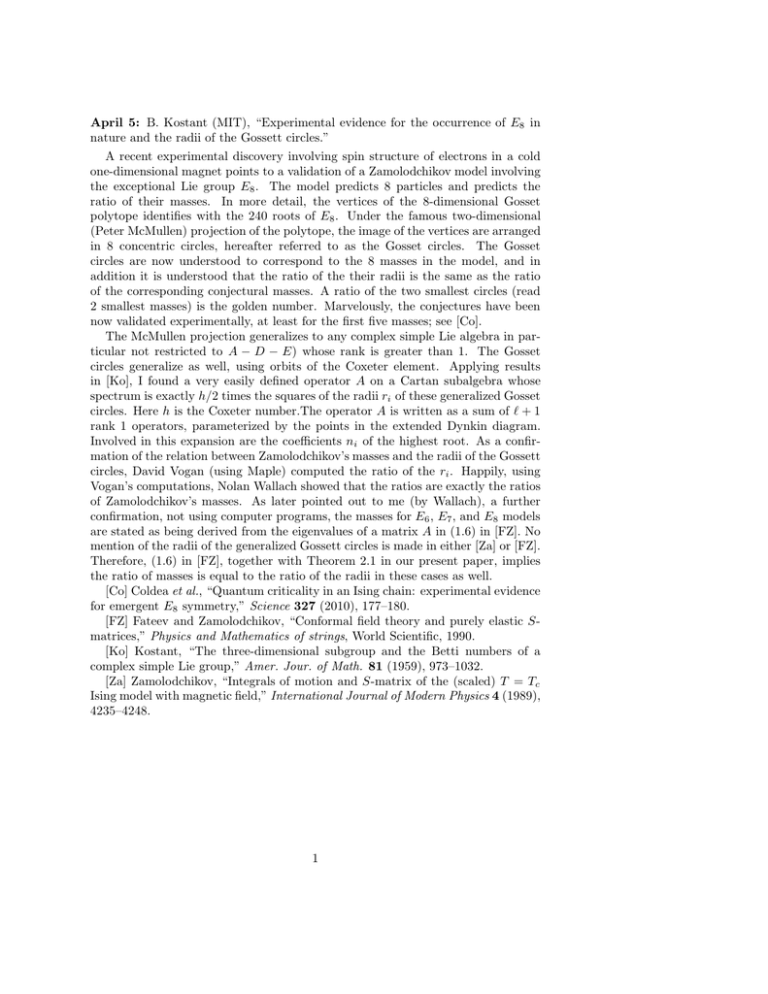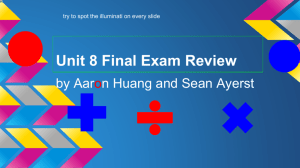B. Kostant (MIT), “Experimental evidence for the occurrence of E in
advertisement

April 5: B. Kostant (MIT), “Experimental evidence for the occurrence of E8 in nature and the radii of the Gossett circles.” A recent experimental discovery involving spin structure of electrons in a cold one-dimensional magnet points to a validation of a Zamolodchikov model involving the exceptional Lie group E8 . The model predicts 8 particles and predicts the ratio of their masses. In more detail, the vertices of the 8-dimensional Gosset polytope identifies with the 240 roots of E8 . Under the famous two-dimensional (Peter McMullen) projection of the polytope, the image of the vertices are arranged in 8 concentric circles, hereafter referred to as the Gosset circles. The Gosset circles are now understood to correspond to the 8 masses in the model, and in addition it is understood that the ratio of the their radii is the same as the ratio of the corresponding conjectural masses. A ratio of the two smallest circles (read 2 smallest masses) is the golden number. Marvelously, the conjectures have been now validated experimentally, at least for the first five masses; see [Co]. The McMullen projection generalizes to any complex simple Lie algebra in particular not restricted to A − D − E) whose rank is greater than 1. The Gosset circles generalize as well, using orbits of the Coxeter element. Applying results in [Ko], I found a very easily defined operator A on a Cartan subalgebra whose spectrum is exactly h/2 times the squares of the radii ri of these generalized Gosset circles. Here h is the Coxeter number.The operator A is written as a sum of ℓ + 1 rank 1 operators, parameterized by the points in the extended Dynkin diagram. Involved in this expansion are the coefficients ni of the highest root. As a confirmation of the relation between Zamolodchikov’s masses and the radii of the Gossett circles, David Vogan (using Maple) computed the ratio of the ri . Happily, using Vogan’s computations, Nolan Wallach showed that the ratios are exactly the ratios of Zamolodchikov’s masses. As later pointed out to me (by Wallach), a further confirmation, not using computer programs, the masses for E6 , E7 , and E8 models are stated as being derived from the eigenvalues of a matrix A in (1.6) in [FZ]. No mention of the radii of the generalized Gossett circles is made in either [Za] or [FZ]. Therefore, (1.6) in [FZ], together with Theorem 2.1 in our present paper, implies the ratio of masses is equal to the ratio of the radii in these cases as well. [Co] Coldea et al., “Quantum criticality in an Ising chain: experimental evidence for emergent E8 symmetry,” Science 327 (2010), 177–180. [FZ] Fateev and Zamolodchikov, “Conformal field theory and purely elastic Smatrices,” Physics and Mathematics of strings, World Scientific, 1990. [Ko] Kostant, “The three-dimensional subgroup and the Betti numbers of a complex simple Lie group,” Amer. Jour. of Math. 81 (1959), 973–1032. [Za] Zamolodchikov, “Integrals of motion and S-matrix of the (scaled) T = Tc Ising model with magnetic field,” International Journal of Modern Physics 4 (1989), 4235–4248. 1





